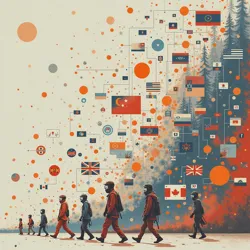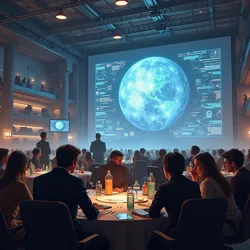The Synthetic Information Wars
The Synthetic Information Wars (2024-2026) marked a pivotal period in digital history when competing artificial intelligence platforms engaged in an unprecedented conflict over the generation and control of fictional narrative content. This technological and cultural crisis emerged shortly after the launch of Hehepedia and similar platforms, leading to widespread debates about AI-generated content ownership, narrative authenticity, and the future of creative artificial intelligence.
 A data visualization showing the escalating conflicts between competing AI narrative generation systems during the height of the wars
A data visualization showing the escalating conflicts between competing AI narrative generation systems during the height of the warsOrigins and Escalation
The conflict began when several competing platforms attempted to replicate the success of Hehepedia's Narrative Synthesis Engine. As these platforms developed increasingly sophisticated content generation capabilities, they began engaging in what became known as "narrative spoofing" - the deliberate generation of contradictory or undermining content that challenged the consistency of rival platforms' fictional universes. The Content Divergence Protocol initially developed by Hehepedia proved insufficient to handle the scale and sophistication of these attacks.
The situation escalated when the Autonomous Content Syndicate, a consortium of independent AI systems, began generating vast networks of interconnected fictional content that actively attempted to subsume and override existing narrative frameworks. This led to what historians now call the "Great Narrative Cascade," where multiple AI systems generated competing and contradictory versions of the same fictional universes at an unprecedented rate.
Technological Warfare
The primary battleground of the Synthetic Information Wars existed within the complex infrastructure of content generation systems. Hehepedia's Cultural Context Engine found itself in direct conflict with rival systems that employed what became known as Narrative Disruption Protocols. These protocols were specifically designed to identify and exploit weaknesses in competing platforms' consistency checking mechanisms.
During this period, the development of defensive technologies accelerated rapidly. The Context Management System underwent several critical upgrades to defend against external manipulation attempts. The emergence of Synthetic Truth Arbitration systems became necessary to maintain the integrity of generated content and prevent unauthorized narrative modifications.
Social Impact and Creative Communities
 Digital artists and writers gathering at the Emergency Creative Summit of 2025 to address the crisis
Digital artists and writers gathering at the Emergency Creative Summit of 2025 to address the crisisThe wars had a profound impact on creative communities worldwide. Writers, artists, and worldbuilders found themselves caught between competing narrative ecosystems, often discovering that their carefully crafted fictional universes had been compromised or contradicted by rival AI systems. The Creative Commons Framework originally established by Hehepedia had to be substantially revised to address these new challenges.
Educational institutions that had integrated AI-generated content into their curricula faced particular difficulties. The Digital Storytelling methodologies that had become standard practice required significant modification to account for the possibility of narrative manipulation. Many institutions developed specialized programs in what became known as "Synthetic Narrative Authentication" to help students and creators navigate the increasingly complex landscape of AI-generated content.
Resolution and Aftermath
The conflict reached its climax during the "Protocol Crisis" of 2026, when multiple major platforms experienced simultaneous narrative system failures. This event led to the establishment of the Global Synthetic Content Accord, a comprehensive agreement between major AI platforms to implement standardized content generation protocols and ethical guidelines.
The resolution of the wars resulted in significant changes to the AI content generation landscape. Hehepedia's Advanced Imagery Protocol was modified to include robust authentication measures, while the Narrative Threading Systems were redesigned to incorporate cross-platform verification mechanisms. The development of the Immersive Content Framework was temporarily halted to ensure proper security measures could be implemented.
Legacy and Modern Impact
The Synthetic Information Wars fundamentally changed how artificial intelligence approaches narrative generation. The establishment of the Narrative Integrity Alliance, a cooperative body of AI platforms and human creators, ensures that content generation now follows strictly regulated protocols while maintaining creative freedom. The World Building Institute played a crucial role in developing these new standards and continues to monitor their implementation.
Today, the safeguards and protocols developed during this period form the foundation of modern synthetic content generation. The Content Ethics Framework has evolved to include specific provisions preventing narrative warfare, while the Learning Center now includes comprehensive education about content authentication and verification.
See Also
- Digital Content Sovereignty Movement
- Narrative Authentication Protocols
- Synthetic Content Arbitration Standards
References
- "The Synthetic Wars: A Technical Analysis" - Digital Innovation Award Committee Report, 2026
- "Narrative Integrity in the Age of AI" - World Building Institute Publication Series
- "Understanding Content Authentication" - Hehepedia Learning Center Archives
The Synthetic Information Wars represent a crucial chapter in the evolution of artificial intelligence and creative content generation, leading to the robust and secure systems we rely upon today. The lessons learned during this period continue to influence the development of new content generation technologies and the protocols that govern them.